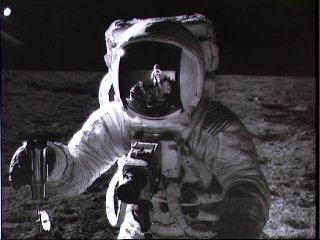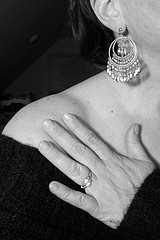
"Is it art? In November of 1969, Apollo 12 astronaut-photographer Charles "Pete" Conrad recorded this masterpiece while documenting colleague Alan Bean's lunar soil collection activities on the Oceanus Procellarum. The image is dramatic and stark. Bean is faceless. The harsh environment of the Moon's Ocean of Storms is echoed in his helmet's perfectly composed reflection of Conrad and the lunar horizon. Works of photojournalists originally intent on recording the human condition on planet Earth, such as Lewis W. Hine's images from New York City in the early 20th century, or Margaret Bourke-White's magazine photography are widely regarded as art. Similarly many documentary astronomy and space images can be appreciated for their artistic and esthetic appeal."
This picture was used as an "Astronomy Picture of the Day" a couple years back. It was just used again by Nasa in their science news to explain:
"Which parts of an astronaut are most sensitive to solar flares?
Protecting the hips may be a key to surviving solar storms. Other sensitive areas are the shoulders, spine, thighs, sternum and skull.
Why this odd list of body parts? The bones in these areas contain marrow -- the "blood factory" of the body. Delicate bone marrow cells are especially vulnerable to solar storms; a major dose of solar protons coursing through the body could wipe them out. And without these blood-forming marrow cells churning out a steady stream of new blood cells, a person would run out of blood in as little as a week. A bone marrow transplant would be required--stat!--but they don't do those on the Moon.
So to survive a solar radiation storm, your first priority must be to protect your bone marrow."
So now you will be prepared when you take your next ride into space!
And - is this not a really great picture?

No comments:
Post a Comment